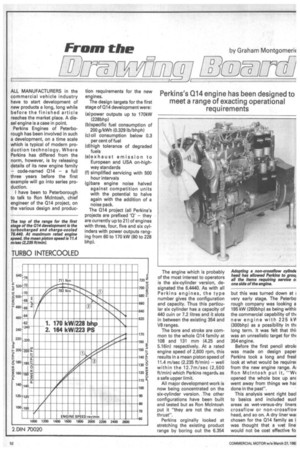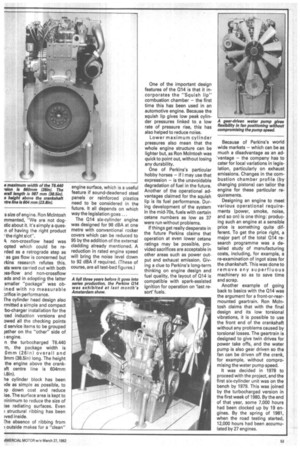Perkins's Q14 engine has been designed to meet a range of exacting operational requirements
Page 44

Page 45

If you've noticed an error in this article please click here to report it so we can fix it.
ALL MANUFACTURERS in the commercial vehicle industry have to start development of new products a long, long while before the finished article reaches the market place. A diesel engine is a case in point.
Perkins Engines of Peterborough has been involved in such a development, on a time scale which is typical of modern production technology. Where Perkins has differed from the norm, however, is by releasing details of its new engine family — code-named 014 — a full three years before the first example will go into series production.
I have been to Peterborough to talk to Ron McIntosh, chief engineer of the Q14 project, on the various design and produc tion requirements for the new engines.
The design targets for the first stage of 014 development were: (a)power outputs up to 170kW (228bhp) (b)specific fuel consumption of 200 g/kWh (0.329 lb/bhph) (c)oil consumption below 0.3 per cent of fuel (d)high tolerance of degraded fuels (e)exhaust emission to European and USA on-highway standards (f) simplified servicing with 500 hour intervals (g)bare engine noise halved against competition units with the potential to halve again with the addition of a noise pack.
The 014 project (all Perkins's projects are prefixed IT — they are currently up to 21) of engines with three, four, five and six cylinders with power outputs ranging from 60 to 170 kW (80 to 228 bhp).
The engine which is probably of the most interest to operators is the six-cylinder version, designated the 6.4440. As with all Perkins engines, the type number gives the configuration and capacity. Thus this particular six cylinder has a capacity of 440 cuin or 7.2 litres and it slots in between the existing 354 and V8 ranges.
The bore and stroke are common to the whole Q14 family at 108 and 131 mm (4.25 and 5.16in) respectively. At a rated engine speed of 2,600 rpm, this results in a mean piston speed of 11.4 misec (2.235 ft/min) — well within the 12.7m/sec (2,500 ft/min) which Perkins regards as a safe upper limit.
All major development work is now being concentrated on the six-cylinder version. The other configurations have been built and tested but as Ron McIntosh put it "they are not the main thrust".
Perkins orginally looked at stretching the existing product range by boring out the 6.354 but this was turned down at very early stage. The Peterbo rough company was looking a 195 kW (260bhp) as being with ii the commercial capability of till new engine with 225 kVl (300bhp) as a possibility in thi long term. It was felt that thi; was an unrealistic target for th4 354 engine.
Before •the first pencil stroki was made on design paper Perkins took a long and fresl look at what would be require( from the new engine range. A: Ron McIntosh put it, "W4 opened the whole box up an went away from things we ha( done in the past".
This analysis went right bad!
to basics and included sucl areas as wet-versus-dry liners crossflow or non-crossflov head, and so on. A dry liner wal chosen for the 014 family as i was thought that a wet line would not be cost effective fo s size of engine. Ron McIntosh mmented, "We are not dogtic about it. It's simply a quesr) of having the right product • the right slot".
non-crossflow head was opted which could be rerded as a retrograde step as • as gas flow is concerned but rkins research refutes this. sts were carried out with both ms-flow and non-crossflow ads and in adopting the latter smaller "package" was obined with no measurable orifice in performance.
rhe cylinder head design also rmitted a simple and compact to-charger installation for the .ced induction versions and owed all the checking points d service items to be grouped lether on the "other" side of engine.
n the turbocharged T6.440 .m, the package width is Omrn (2 6in) overall and 3mm (38.5in) long. The height the engine above the crankaft centre line is 604mm 1.8in).
he cylinder block has been ide as simple as possible, to ap down cost and reduce ise. The surface area is kept to ninimum to reduce the size of ise radiating surfaces. Even ) structural ribbing has been wed inside.
rhe absence of ribbing from ) outside makes for a "clean" engine surface, which is a useful feature if sound-deadened steel panels or reinforced plastics need to be considered in the future. It all depends on which way the legislation goes ...
The 014 six-cylinder engine was designed for 98 dBA at one metre with conventional rocker covers which can be reduced to 95 by the addition of the external cladding already mentioned. A reduction in rated engine speed will bring the noise level down to 92 dBA if required. (These of course, are all test-bed figures.) One of the important design features of the 014 is that it incorporates the "Squish lip" combustion chamber — the first time this has been used in an automotive engine. Because the squish lip gives low peak cylinder pressures linked to a low rate of pressure rise, this has also helped to reduce noise.
Lower maximum cylinder pressures also mean that the whole engine structure can be lighter but, as Ron McIntosh was quick to point out, without losing any durability.
One of Perkins's particular hobby horses — if I may use that expression — is the unavoidable degradation of fuel in the future. Another of the operational advantages claimed for the squish lip is its fuel performance. During development of the system in the mid-70s, fuels with certain cetane numbers as low as 37 were run without problems.
If things get really desperate in the future Perkins claims that operation at even lower cetane ratings may be possible, provided sacrifices are acceptable in other areas such as power output and exhaust emission. Giving a clue to Perkins's long-term thinking on engine design and fuel quality, the layout of 014 is compatible with spark-assisted ignition for operation on 'last resort' fuels. Because of Perkins's world wide markets — which can be as much a disadvantage as an advantage — the company has to cater for local variations in legislation, particularly on exhaust emissions. Changes in the combustion chamber profile (by changing pistons) can tailor the engine for these particular requirements.
Designing an engine to meet various operational requirements (power, smoke, noise, and so on) is one thing: producing such an engine at a sensible price is something quite different. To get the price right, a major part of the total 014 research programme was a detailed study of manufacturing costs, including, for example, a re-examination of ingot sizes for the chankshaft. This was done to remove any superfluous machinery so as to save time and scrap.
Another example of going back to basics with the 014 was the argument for a front-or-rearmounted geartrain. Ron McIntosh claims that with the final design and its low torsional vibrations, it is possible to use the front end of the crankshaft without any problems caused by torsional losses. The geartrain is designed to give twin drives for power take offs, and the water pump is also gear driven so the fan can be driven off the crank, for example, without compromising the water pump speed.
It was decided in 1978 to proceed with the project, and the first six-cylinder unit was on the bench by 1979. This was joined by the turbocharged version in the first week of 1980. By the end of that year, some 7,000 hours had been clocked up by 19 engines. By the spring of 1981, when the road testing started, 12,000 hours had been accumulated by 27 engines.


















































